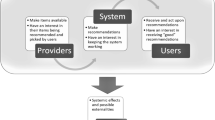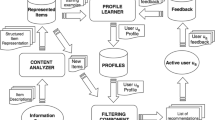Abstract
The existing online medical platforms are striving to provide various kinds of services to satisfy users' dynamic demands. With the exponential growth of information, users usually suffer from information overload, confronting with high search costs and time costs. In order to reduce users' search cost and assist users to retrieve appropriate medical service efficiently, recommending online medical services to users smarter and faster has becoming a valuable research topic. Unfortunately, certain imprecise and subjective information always exist in obtaining users' preferences. Moreover, the effect of social trust on an individual user's decision-making is often omitted in previous methods, which may result in inaccurate recommendation results. This study proposes a method for recommending the most appropriate medical services to users, in which users' linguistic preferences, assessments and social trust information are considered. The procedure of the proposed method consists of two steps: (1) to acquire various users' linguistic preference based on Best–Worst Method (BWM) and fuzzy set theory, and (2) to recommend the corresponding medical services using trust-aware collaborative filtering (CF) technique. Firstly, the fuzzy BWM is adopted to determine the attribute weights based on various users' linguistic preferences. Secondly, by combing the linguistic evaluation matrix and users' social trust information, the trust-based similarity network is constructed, which is then merged into CF technique for predicting final rating and recommending online medical services. Finally, a case study is conducted to demonstrate the applications of the proposed method.





Similar content being viewed by others
References
Yang, Y., Zhang, X., Lee, P.: Improving the effectiveness of online healthcare platforms: An empirical study with multi-period patient-doctor consultation data. Int. J. Prod. Econ. 207(1), 70–80 (2019)
Hallikas, J., Immonen, M., Pynneonen, M., Mikkonen, K.: Service purchasing and value creation: towards systemic purchases. Int. J. Prod. Econ. 147(1), 53–61 (2014)
Liu, D.R., Shih, Y.Y.: Integrating AHP and data mining for product recommendation based on customer lifetime value. Information and Management 42(3), 387–400 (2005)
Zhang, Y., Chen, M., Huang, D., Wu, D., Li, Y.: IDoctor: personalized and professionalized medical recommendations based on hybrid matrix factorization. Futur. Gener. Comput. Syst. 66(1), 30–35 (2017)
Zhang, W.Y., Zhang, S., Chen, Y.G., Pan, X.W.: Combining social network and collaborative filtering for personalized manufacturing service recommendation. Int. J. Prod. Res. 51(22), 6702–6719 (2013)
Wang, C.H.: A market-oriented approach to accomplish product positioning and product recommendation for smart phones and wearable devices. Int. J. Prod. Res. 53(8), 2542–2553 (2015)
Ziegler CN, Mcnee SM, Konstan JA, Lausen G.: Improving recommendation lists through topic diversification. In: Proceedings of the 14th International Conference on World Wide Web. Chiba, Japan, pp. 22–32 (2005)
Cai, Z.Q., Hu, H.: Session-aware music recommendation via a generative model approach. Soft. Comput. 22(3), 1023–1031 (2018)
Mohammadi, M., Rezaei, J.: Bayesian best-worst method: a probabilistic group decision making model. Omega 96, 102075 (2020)
Liu, P., Zhu, B., Wang, P.: A weighting model based on best–worst method and its application for environmental performance evaluation. Appl. Soft Comput. 103, 107168 (2021)
Liu, P.D., Hendalianpour, A., Fakhrabadi, M., et al.: Integrating IVFRN-BWM and goal programming to allocate the order quantity considering discount for green supplier. Int. J. Fuzzy Syst. 24(2), 989–1011 (2022)
Faizi, S., Sałabun, W., Nawaz, S., Rehman, A., Wątróbski, J.: Best-Worst method and Hamacher aggregation operations for intuitionistic 2-tuple linguistic sets. Expert Syst. Appl. 181, 115088 (2021)
Dong, J., Wan, S., Chen, S.M.: Fuzzy best-worst method based on triangular fuzzy numbers for multi-criteria decision-making. Inf. Sci. 547, 1080–1104 (2021)
Wankhede, VA, & Vinodh, S.: Analysis of industry 4.0 challenges using best worst method: A case study. Computers & Industrial Engineering, 159, 107487 (2021)
Kotiloglu, S., Lappas, T., Pelechrinis, K., Repoussis, P.P.: Personalized multi-period tour recommendations. Tour. Manage. 62(5), 76–88 (2017)
Hwangbo, H., Kim, Y.S., Cha, K.J.: Recommendation system development for fashion retail e-commerce. Electron. Commer. Res. Appl. 28(2), 94–101 (2018)
Wang, M.L., Ma, J.: A novel recommendation approach based on users’ weighted trust relations and the rating similarities. Soft. Comput. 20(10), 3981–3990 (2016)
Parvin, H., Moradi, P., Esmaeili, S.: TCFACO: trust-aware collaborative filtering method based on ant colony optimization. Expert Syst. Appl. 118(6), 152–168 (2019)
Adomavicius, G., Tuzhilin, A.: Toward the next generation of recommender systems: a survey of the state-of-the-art and possible extensions. IEEE Trans. Knowl. Data Eng. 17(6), 734–749 (2005)
Jannach, D., Karakaya, Z., Gedikli, F.: Accuracy improvements for multi-criteria recommender systems. In: Proceedings of the 13th ACM Conference on Electronic Commerce. Valencia, Spain, pp. 674–689 (2012)
Adomavicius, G., Kwon, Y.O.: New recommendation techniques for multicriteria rating systems. IEEE Intell. Syst. 22(3), 48–55 (2007)
Fan, Z.P., Zhang, X., Chen, F.D., Liu, Y.: Multiple attribute decision making considering aspiration-levels: a method based on prospect theory. Comput. Ind. Eng. 65(2), 341–350 (2013)
Fan, Z.P., Xi, Y., Liu, Y.: Supporting consumer’s purchase decision: a method for ranking products based on online multi-attribute product ratings. Soft. Comput. 22(16), 5247–5261 (2018)
Liu, Y., Fan, Z.P., Zhang, Y.: A method for stochastic multiple criteria decision making based on dominance degrees. Inf. Sci. 181(19), 4139–4153 (2011)
Ortega, F, Mayor J, Lopez-Fernandez D, et al.: CF4J 2.0: Adapting collaborative filtering for Java to new challenges of collaborative filtering based recommender systems. Knowledge-Based Systems, 215, 94–99 (2021)
Jian, M., Zhang, C.L., Liu, M.S., et al.: Siamese graph-based dynamic matching for collaborative filtering. Inf. Sci. 611, 185–198 (2022)
Singh, P.K., Othman, E., Ahmed, R., et al.: Optimized recommendations by user profiling using apriori algorithm. Appl. Soft Comput. 106, 107272 (2021)
Wang, F., Zhu, H.B., Srivastava, G., et al.: Robust collaborative filtering recommendation with user-item-trust records. IEEE Trans. Comput. Soc. Syst. 9(4), 986–996 (2022)
Liang, T.T., Chen, M.N., Yin, Y.Y., et al.: Recurrent neural network based collaborative filtering for QoS prediction in IoV. IEEE Trans. Intell. Transp. Syst. 23(3), 2400–2410 (2022)
Chen, T.C.T., Chiu, M.C.: Mining the preferences of patients for ubiquitous clinic recommendation. Health Care Management Science. https://doi.org/10.1007/s10729-018-9441-y (2020)
Huang, Z.X., Lu, X.D., Duan, H.L., Zhao, C.H.: Collaboration-based medical knowledge recommendation. Artif. Intell. Med. 55(1), 13–24 (2012)
Kim, K.J., Ahn, H.: Recommender systems using cluster-indexing collaborative filtering and social data analytics. Int. J. Prod. Res. 55(17), 5037–5049 (2017)
Lu, J., Wu, D.S., Mao, M.S., Wang, W., Zhang, G.Q.: Recommender system application developments: a survey. Decis. Support Syst. 74(6), 12–32 (2015)
Lee, W.P., Ma, C.Y.: Enhancing collaborative recommendation performance by combining user preference and trust-distrust propagation in social networks. Knowl.-Based Syst. 106(6), 125–134 (2016)
Wu, J., Chang, J.L., Cao, Q.W., Liang, C.Y.: A trust propagation and collaborative filtering based method for incomplete information in social network group decision making with type-2 linguistic trust. Comput. Ind. Eng. 127(12), 853–864 (2019)
Zadeh, L.A.: Fuzzy sets. Inf. Control 8(3), 338–353 (1965)
Pedrycz, W.: Why triangular membership functions? Fuzzy Sets Syst. 64(1), 21–30 (1994)
Chen, X., Li, Z.W., Fan, Z.P., Zhou, X.Y., Zhang, X.: Matching demanders and suppliers in knowledge service: a method based on fuzzy axiomatic design. Inf. Sci. 346–347(6), 130–145 (2016)
Fan, Z.P., Li, Y.H., Wang, X.H., Liu, Y.: Hybrid similarity measure for case retrieval in CBR and its application to emergency response towards gas explosion. Expert Syst. Appl. 41(5), 2526–2534 (2014)
Kaufmann, A., Gupta, M.M.: Introduction to Fuzzy Arithmetic: Theory and Applications. Van Nostrand Reinhold Company, New York (1985)
Li, D.F.: A ratio ranking method of triangular intuitionistic fuzzy numbers and its application to MADM problems. Comput. Math. Appl. 60(6), 1557–1570 (2010)
Rezaei, J.: Best-worst multi-criteria decision-making method. Omega 53(4), 49–57 (2015)
Saaty, T.L.: The Analytic Hierarchy Process. McGraw Hill Company, New York (1980)
Mi, X., Tang, M., Liao, H., Shen, W., Lev, B.: The state-of-the-art survey on integrations and applications of the best worst method in decision making: Why, what, what for and what’s next? Omega 87, 205–225 (2019)
Hafezalkotob, A., Hafezalkotob, A.: A novel approach for combination of individual and group decisions based on fuzzy best-worst method. Appl. Soft Comput. 59(10), 316–325 (2017)
Zadeh, L.A.: The concept of a linguistic variable and its application to approximate reasoning-I. Inf. Sci. 8(3), 199–249 (1975)
van Laarhoven, P.J.M., Pedrycz, W.: A fuzzy extension of Saaty’s priority theory. Fuzzy Sets Syst. 11(1–3), 199–227 (1983)
Lootsma, F.A.: Saaty’s priority theory and the nomination of a senior professor in operations Research. Eur. J. Oper. Res. 4(6), 380–388 (1980)
Jiang, Y.P., Fan, Z.P.: A method for group decision making with multi-granularity linguistic assessment information. Inf. Sci. 178(4), 1098–1109 (2008)
Al-Oufi, S., Kim, H.N., El Saddik, A.: A group trust metric for identifying people of trust in online social networks. Expert Syst. Appl. 39(18), 13173–13181 (2012)
Chen, S., Luo, T., Liu, W., Xu, Y..: Incorporating Similarity and Trust for Collaborative Filtering. In: Proceedings of the Sixth International Conference on Fuzzy Systems and Knowledge Discovery. Tianjin, China, pp.487–493 (2009)
Liu, Y., Bi, J.W., Fan, Z.P.: A method for ranking products through online reviews based on sentiment classification and interval-valued intuitionistic fuzzy TOPSIS. Int. J. Inf. Technol. Decis. Mak. 16(6), 1497–1522 (2017)
Funding
This study was partially supported by the National Natural Science Foundation of China (Program Nos. 71974154), the Natural Science Foundation of Shaanxi Province (Program No. 2019JM-110), the Shaanxi Provincial Youth Talent Support Program, and the Fundamental Research Funds for the Central Universities (Project Nos. JB190604, 20101235636). Also sponsored by the Seed Foundation of Innovation Practice for Graduate Students in Xidian University.
Author information
Authors and Affiliations
Corresponding author
Ethics declarations
Conflict of interest
Author Xi Chen declares that she has no conflict of interest. Author Yuan Luo declares that she has no conflict of interest. Author Qirui Wu declares that he has no conflict of interest. Author WenBo Zhang declares that he has no conflict of interest.
Rights and permissions
Springer Nature or its licensor (e.g. a society or other partner) holds exclusive rights to this article under a publishing agreement with the author(s) or other rightsholder(s); author self-archiving of the accepted manuscript version of this article is solely governed by the terms of such publishing agreement and applicable law.
About this article
Cite this article
Chen, X., Luo, Y., Wu, Q. et al. How to Recommend Online Medical Service Smarter and Faster? A Novel Decision-Making Method Considering Users' Linguistic Preference and Trust Propagation. Int. J. Fuzzy Syst. 25, 2828–2846 (2023). https://doi.org/10.1007/s40815-023-01533-x
Received:
Revised:
Accepted:
Published:
Issue Date:
DOI: https://doi.org/10.1007/s40815-023-01533-x




